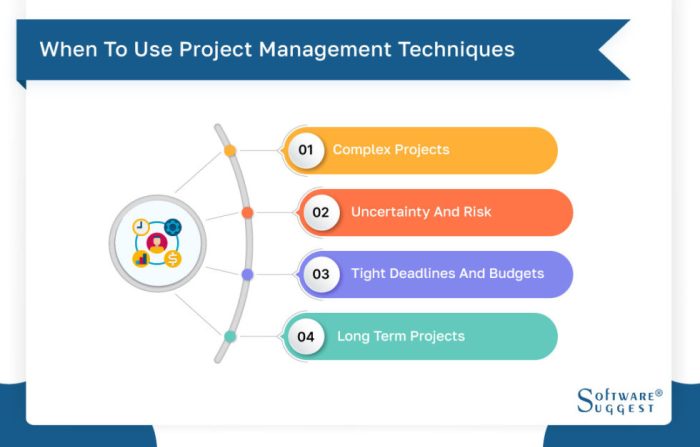Project Management Techniques: Delving into the world of effective project management strategies, this intro sets the stage for a captivating exploration of key techniques and their impact on organizational success.
Get ready to uncover the secrets behind agile project management, Scrum methodology, Kanban system, and Critical Path Method (CPM) in this engaging journey through modern project management practices.
Project Management Techniques
Project management techniques are methods or strategies used to plan, execute, and monitor projects to ensure they are completed successfully within scope, time, and budget constraints. These techniques help project managers and teams stay organized, efficient, and focused on achieving project goals.
Examples of Commonly Used Project Management Techniques:
- Waterfall Methodology: A sequential approach where each phase of the project is completed before moving on to the next.
- Agile Methodology: An iterative approach that involves breaking down the project into smaller tasks and adapting to changes quickly.
- Critical Path Method (CPM): A technique used to identify the longest sequence of dependent tasks and determine the shortest possible project duration.
- PERT (Program Evaluation and Review Technique): A method for analyzing and representing the tasks involved in completing a project.
The Importance of Implementing Effective Project Management Techniques in Organizations:
Effective project management techniques are crucial for organizations to ensure successful project delivery. By utilizing the right techniques, organizations can improve efficiency, minimize risks, and enhance communication among team members. Additionally, implementing these techniques helps in meeting project objectives, delivering quality results, and satisfying stakeholders’ expectations.
Agile Project Management

Agile project management is a modern approach that focuses on flexibility, collaboration, and continuous improvement throughout the project lifecycle. It emphasizes adaptability to change, customer satisfaction, and delivering value in shorter timeframes.
Principles of Agile Project Management
- Iterative and Incremental Development: Projects are divided into small, manageable iterations that deliver incremental value.
- Customer Collaboration: Involving customers throughout the project to ensure their requirements are met.
- Adaptive Planning: Embracing change and adjusting plans based on feedback and evolving requirements.
- Self-organizing Teams: Empowering teams to make decisions and collaborate effectively.
- Continuous Improvement: Reflecting on the project process and making adjustments to improve efficiency and quality.
Comparison with Traditional Project Management
- Traditional project management follows a linear, sequential approach, while agile is iterative and flexible.
- Agile focuses on delivering value early and frequently, whereas traditional methods prioritize comprehensive planning upfront.
- Traditional project management relies on detailed documentation and strict processes, while agile values working software and customer collaboration.
Enhancing Project Delivery and Adaptability
- Agile techniques promote quicker response to change, allowing teams to adapt to evolving requirements and market conditions.
- By emphasizing collaboration and communication, agile project management fosters a more responsive and customer-centric approach.
- Continuous feedback loops in agile projects help identify issues early and make necessary adjustments to ensure project success.
Scrum Methodology: Project Management Techniques
Scrum methodology is a popular approach in project management that emphasizes teamwork, accountability, and iterative progress. It is often used in software development projects but can be applied to various industries.
Roles and Responsibilities within a Scrum Team
In a Scrum team, there are three primary roles: Product Owner, Scrum Master, and Development Team. The Product Owner is responsible for defining the project vision, managing the product backlog, and prioritizing tasks. The Scrum Master facilitates the Scrum process, removes obstacles, and ensures the team adheres to Scrum practices. The Development Team consists of professionals who work together to deliver increments of the product.
- The Product Owner collaborates with stakeholders to define project requirements and priorities.
- The Scrum Master guides the team in following Scrum principles and practices.
- The Development Team self-organizes to complete tasks and deliver value.
Effective communication and collaboration among team members are crucial in ensuring project success.
Improved Collaboration and Efficiency in Project Execution
Scrum methodology improves collaboration and efficiency by promoting transparency, adaptability, and continuous improvement. Daily stand-up meetings, sprint planning sessions, and sprint reviews enable teams to communicate effectively, identify challenges early, and adjust course as needed.
- Regular feedback loops allow for quick adjustments and continuous learning.
- Sprints focus on delivering tangible results within a short timeframe, increasing productivity.
- The iterative approach of Scrum enables teams to respond to change and deliver value incrementally.
Kanban System

The Kanban system is a visual project management method that helps teams track and manage work efficiently. It focuses on improving workflow and reducing waste by visualizing tasks on a Kanban board.
Key Principles of Kanban System
- Visualize Work: The Kanban board displays tasks in different stages, allowing team members to see what needs to be done at a glance.
- Limit Work in Progress (WIP): By setting limits on the number of tasks in progress, teams can improve focus and productivity.
- Manage Flow: Kanban emphasizes the smooth flow of work from start to finish, minimizing bottlenecks and delays.
- Continuous Improvement: Teams can use data from the Kanban board to identify areas for improvement and make adjustments to optimize their workflow.
Benefits of Using Kanban System
- Task Prioritization: Kanban helps teams prioritize tasks based on their importance and urgency, ensuring that the most critical work gets done first.
- Increased Productivity: By visualizing workflow and limiting work in progress, teams can improve efficiency and get more done in less time.
- Flexibility: Kanban allows teams to adapt to changing priorities and requirements quickly, making it ideal for projects with evolving needs.
- Transparency: The Kanban board provides transparency into the status of tasks, making it easy for team members and stakeholders to track progress.
Critical Path Method (CPM)
The Critical Path Method (CPM) is a project management technique used to identify the longest sequence of dependent tasks and determine the shortest possible duration for completing a project. By focusing on the critical path, project managers can ensure that the project stays on track and is completed in a timely manner.
Calculating the Critical Path, Project Management Techniques
To calculate the critical path in a project, follow these steps:
- List all the tasks involved in the project and their dependencies.
- Determine the duration of each task.
- Identify the earliest start time and latest finish time for each task.
- Calculate the earliest start and finish times for each task by working backwards from the project’s end date.
- Find the critical path by identifying the tasks with the longest total duration.
Significance of CPM
Using CPM helps project managers identify the critical tasks that directly impact the project timeline. By focusing on the critical path, managers can allocate resources effectively, prioritize tasks, and ensure that the project is completed within the shortest possible time frame.





